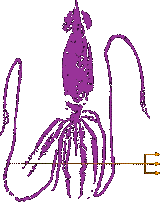

Squid's 11 inch eye is largest on earth
Squid's 11 inch eye is largest on earth
Marine scientists studying the carcass of a rare
colossal squid said Wednesday they had measured its
eye at about 11 inches across ...

This handout file picture shows Captain John Bennett
examining the world's first intact adult male colossal squid
on board his New Zealand fishing long-line boat in the Ross Sea
near Antarctica on February 22, 2007.
The biggest squid ever caught, at up to 10 meters long and boasting
a fearsome beak and razor-sharp hooks, may be small
compared to others still lurking in the depths, scientists
said on April 29, 2008. The colossal squid has begun a two-day
thaw at the Museum of New Zealand in Wellington
before it is examined in more detail by an international
team of scientists.

WELLINGTON, New Zealand — Marine scientists studying
the carcass of a rare colossal squid said Wednesday they
had measured its eye at about 11 inches across
— bigger than a dinner plate —
making it the largest animal eye on Earth.
One of the squid's two eyes, with a lens as big
as an orange, was found intact as the scientists examined
the creature while it was slowly defrosted at New Zealand's
national museum, Te Papa Tongarewa. It has been preserved
there since being caught in the Ross Sea off Antarctica's northern coast last year.
"This is the only intact eye [of a colossal squid]
that's ever been found. It's spectacular," said
Auckland University of Technology squid specialist
Kat Bolstad, one of a team of international
scientists examining the creature.
"It's the largest known eye in the animal kingdom,"

Bolstad told The Associated Press.
The squid is the
biggest specimen ever caught of the rare deep-water species
Mesonychoteuthis hamiltoni, or colossal squid.
When caught, it measured 26 feet long and weighed about
1,000 pounds, but scientists believe the species may
grow as long as 46 feet.
"This is the largest eye ever recorded in history
and studied," said Swedish Professor Eric Warrant
of the University of Lund, who specializes in vision
in invertebrates. "It has a huge lens the size of an orange
and captures an awful lot of light in the dark depths
in which it hunts."
The squids can descend to 6,500 feet
and are known to be aggressive hunters.
Scientists using an endoscope to examine the stomach
and other organs said later Wednesday on their blog that
the squid was a female.
"We just found the ovaries — the specimen is a girl!
The ovaries are full of several thousands of eggs!"
Bolstad earlier said that females
are believed to grow larger than the male.
Five facts about the Colossal Squid
1 The Colossal (or Antarctic) Squid,
Mesonychoteuthis Hamiltoni,
was first identified in 1925 after two tentacles
were found in the stomach of a sperm whale.
Until this catch, no male had been landed intact.
2 It is heavier, but generally slightly shorter
— 43ft long to 46ft —
than its better-known cousin, the Giant Squid.
3 Its habitat extends from Antarctica
to the southern extremities of South America,
South Africa and New Zealand, but very few have been sighted.
4 Colossal Squid can live at
depths of more than 7,000 feet.
They are aggressive hunters of large fish
and other squid for prey. They are eaten by whales.
Sperm whales can often be left with the scars of battle.
5 Scientists estimate there
are about 500 species of squid,
with the smallest only two centimetres long.
